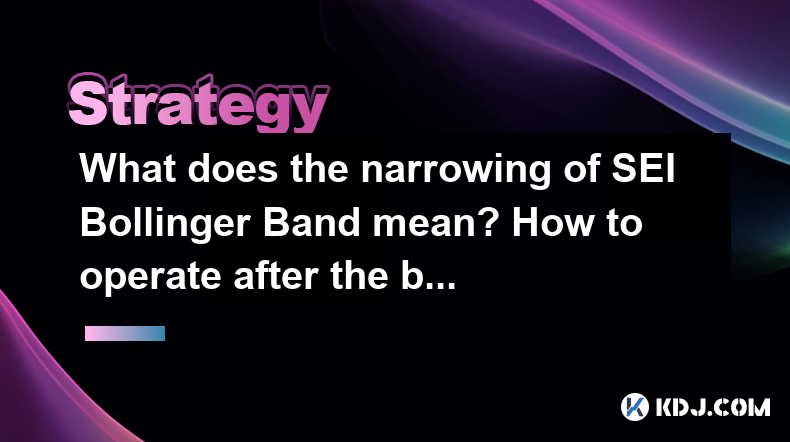-
 bitcoin
bitcoin $122025.899241 USD
-2.12% -
 ethereum
ethereum $4488.068729 USD
-4.11% -
 bnb
bnb $1315.348019 USD
8.65% -
 tether
tether $1.000457 USD
0.03% -
 xrp
xrp $2.875326 USD
-3.69% -
 solana
solana $222.043604 USD
-4.07% -
 usd-coin
usd-coin $0.999682 USD
0.00% -
 dogecoin
dogecoin $0.249887 USD
-5.62% -
 tron
tron $0.337379 USD
-2.59% -
 cardano
cardano $0.827763 USD
-5.06% -
 hyperliquid
hyperliquid $45.774531 USD
-2.43% -
 chainlink
chainlink $22.079309 USD
-5.87% -
 ethena-usde
ethena-usde $1.000156 USD
0.02% -
 sui
sui $3.482566 USD
-3.57% -
 stellar
stellar $0.386982 USD
-4.92%
What does the narrowing of SEI Bollinger Band mean? How to operate after the breakthrough?
The narrowing of the SEI Bollinger Band signals low volatility and a potential breakout, prompting traders to prepare for significant price movements in the cryptocurrency market.
May 03, 2025 at 06:14 pm

The narrowing of the SEI Bollinger Band is a significant indicator used by traders in the cryptocurrency market to assess potential market movements. The Bollinger Band, developed by John Bollinger, consists of a middle band being a simple moving average (SMA) and two outer bands that are standard deviations away from the SMA. When the bands narrow, it suggests that the market is experiencing low volatility, which often precedes a significant price movement. In this article, we will explore what the narrowing of the SEI Bollinger Band means and how to operate after a breakthrough.
Understanding the SEI Bollinger Band
The SEI Bollinger Band is a specific application of the Bollinger Band to the SEI cryptocurrency. It works similarly to the standard Bollinger Band, but it is tailored to the unique characteristics of the SEI token. The band consists of three lines: the middle line, which is typically a 20-day simple moving average, and the upper and lower bands, which are usually set two standard deviations away from the middle line.
What Does the Narrowing of the SEI Bollinger Band Mean?
When the SEI Bollinger Band narrows, it indicates that the price of the SEI token is experiencing low volatility. This means that the price is moving within a tight range, and the upper and lower bands are converging towards the middle band. This phenomenon is often referred to as the Bollinger Band Squeeze.
The narrowing of the SEI Bollinger Band is significant because it suggests that the market is in a period of consolidation. This consolidation period can be a precursor to a significant price movement, either upward or downward. Traders often look for this signal as an indication that a breakout is imminent.
How to Identify the Narrowing of the SEI Bollinger Band
To identify the narrowing of the SEI Bollinger Band, traders should follow these steps:
- Open your trading platform that supports technical analysis tools.
- Add the Bollinger Band indicator to your chart for the SEI token.
- Observe the bands over a period of time. If you notice that the upper and lower bands are getting closer to the middle band, the Bollinger Band is narrowing.
What to Expect After the Narrowing of the SEI Bollinger Band
After the SEI Bollinger Band narrows, traders should be prepared for a potential breakout. A breakout occurs when the price of the SEI token moves outside of the upper or lower band. This movement can signal the beginning of a new trend.
The direction of the breakout is not guaranteed, so traders must be ready for either an upward or downward movement. However, the magnitude of the breakout is often significant because the energy built up during the period of low volatility is released.
How to Operate After the Breakthrough of the SEI Bollinger Band
Once the SEI Bollinger Band has narrowed and a breakout occurs, traders need to act swiftly and strategically. Here are the steps to follow after a breakthrough:
- Confirm the Breakout: Before taking any action, ensure that the breakout is genuine. A false breakout can occur, so wait for the price to close outside the band.
- Determine the Direction: Analyze the direction of the breakout. If the price breaks above the upper band, it suggests a bullish trend. If it breaks below the lower band, it indicates a bearish trend.
- Set Entry Points: Based on the direction of the breakout, set your entry points. For a bullish breakout, consider entering a long position. For a bearish breakout, consider entering a short position.
- Set Stop-Loss Orders: To manage risk, set stop-loss orders just below the breakout level for long positions or just above the breakout level for short positions.
- Monitor the Trade: Keep a close eye on the trade after entering. Be prepared to exit the trade if the market moves against your position.
Practical Example of Operating After a SEI Bollinger Band Breakthrough
Let's consider a practical example to illustrate how to operate after a breakthrough of the SEI Bollinger Band:
- Scenario: The SEI Bollinger Band has been narrowing for the past few weeks, and today, the price of SEI breaks above the upper band.
- Confirmation: You wait for the price to close above the upper band to confirm the breakout.
- Direction: The breakout is upward, indicating a potential bullish trend.
- Entry Points: You decide to enter a long position at the current market price of $10.
- Stop-Loss Orders: You set a stop-loss order at $9.50, just below the breakout level.
- Monitoring: You monitor the trade closely. If the price continues to rise, you might consider adjusting your stop-loss to lock in profits. If the price falls back below the upper band, you might exit the trade to minimize losses.
Risk Management and the SEI Bollinger Band
Risk management is crucial when trading based on the SEI Bollinger Band. The band can provide valuable insights into potential market movements, but it is not foolproof. Traders should always use other technical indicators and fundamental analysis to confirm their trading decisions.
Additionally, traders should never risk more than they can afford to lose. Setting appropriate stop-loss orders and position sizes can help manage risk effectively.
Combining the SEI Bollinger Band with Other Indicators
While the SEI Bollinger Band is a powerful tool, it can be even more effective when combined with other technical indicators. Some popular indicators to use alongside the Bollinger Band include:
- Relative Strength Index (RSI): The RSI can help confirm overbought or oversold conditions, which can complement the signals provided by the Bollinger Band.
- Moving Average Convergence Divergence (MACD): The MACD can provide additional confirmation of trend direction and momentum.
- Volume: High volume during a breakout can confirm the strength of the move, making it more likely to be sustained.
Frequently Asked Questions
Q: Can the SEI Bollinger Band be used for all timeframes?A: Yes, the SEI Bollinger Band can be applied to various timeframes, from short-term intraday charts to longer-term daily or weekly charts. However, the settings of the Bollinger Band, such as the period of the moving average and the number of standard deviations, may need to be adjusted based on the timeframe you are using.
Q: How often should I check the SEI Bollinger Band for trading opportunities?A: The frequency of checking the SEI Bollinger Band depends on your trading style. For day traders, checking the band multiple times throughout the day can be beneficial. For swing traders or long-term investors, checking the band on a daily or weekly basis may be sufficient.
Q: Is the SEI Bollinger Band suitable for beginners?A: While the SEI Bollinger Band can be a valuable tool for all traders, beginners should take the time to understand how it works and practice using it in a demo account before applying it to live trading. Combining the Bollinger Band with other indicators and learning risk management techniques can help beginners use it effectively.
Q: Can the SEI Bollinger Band be used for other cryptocurrencies?A: Yes, the principles of the Bollinger Band can be applied to any cryptocurrency. However, the specific settings and interpretations may vary depending on the volatility and characteristics of the cryptocurrency being analyzed.
Disclaimer:info@kdj.com
The information provided is not trading advice. kdj.com does not assume any responsibility for any investments made based on the information provided in this article. Cryptocurrencies are highly volatile and it is highly recommended that you invest with caution after thorough research!
If you believe that the content used on this website infringes your copyright, please contact us immediately (info@kdj.com) and we will delete it promptly.
- BlockDAG, DOGE, HYPE Sponsorship: Crypto Trends Shaping 2025
- 2025-10-01 00:25:13
- Deutsche Börse and Circle: A StableCoin Adoption Powerhouse in Europe
- 2025-10-01 00:25:13
- BlockDAG's Presale Buzz: Is It the Crypto to Watch in October 2025?
- 2025-10-01 00:30:13
- Bitcoin, Crypto, and IQ: When Genius Meets Digital Gold?
- 2025-10-01 00:30:13
- Stablecoins, American Innovation, and Wallet Tokens: The Next Frontier
- 2025-10-01 00:35:12
- NBU, Coins, and Crypto in Ukraine: A New Yorker's Take
- 2025-10-01 00:45:14
Related knowledge

Practical parameter settings for a Bitcoin multi-timeframe moving average system
Sep 18,2025 at 10:54pm
Optimizing Timeframe Combinations for Bitcoin Trading1. Selecting appropriate timeframes is crucial when building a multi-timeframe moving average sys...

How can I filter out false breakouts in Dogecoin high-frequency trading?
Sep 22,2025 at 01:00am
Understanding False Breakouts in Dogecoin Trading1. A false breakout occurs when Dogecoin's price appears to move beyond a defined support or resistan...

Techniques for identifying tops and bottoms in the Bitcoin on-chain NVT model
Sep 20,2025 at 07:54pm
Understanding the NVT Model in Bitcoin Analysis1. The Network Value to Transactions (NVT) ratio is often described as the 'P/E ratio' of the cryptocur...

What does the surge in open interest in Bitcoincoin futures mean?
Sep 20,2025 at 11:18pm
Understanding the Surge in Dogecoin Futures Open Interest1. A surge in open interest within Dogecoin futures indicates a growing number of active cont...

How can I use the Ethereum USDT premium to gauge market sentiment?
Sep 18,2025 at 11:55pm
Understanding the Ethereum USDT Premium1. The Ethereum USDT premium refers to the price difference between USDT (Tether) traded on Ethereum-based plat...

What should I do if Ethereum staking yields decline?
Sep 20,2025 at 06:18am
Understanding the Causes Behind Declining Ethereum Staking Yields1. The Ethereum network transitioned to a proof-of-stake consensus mechanism with the...

Practical parameter settings for a Bitcoin multi-timeframe moving average system
Sep 18,2025 at 10:54pm
Optimizing Timeframe Combinations for Bitcoin Trading1. Selecting appropriate timeframes is crucial when building a multi-timeframe moving average sys...

How can I filter out false breakouts in Dogecoin high-frequency trading?
Sep 22,2025 at 01:00am
Understanding False Breakouts in Dogecoin Trading1. A false breakout occurs when Dogecoin's price appears to move beyond a defined support or resistan...

Techniques for identifying tops and bottoms in the Bitcoin on-chain NVT model
Sep 20,2025 at 07:54pm
Understanding the NVT Model in Bitcoin Analysis1. The Network Value to Transactions (NVT) ratio is often described as the 'P/E ratio' of the cryptocur...

What does the surge in open interest in Bitcoincoin futures mean?
Sep 20,2025 at 11:18pm
Understanding the Surge in Dogecoin Futures Open Interest1. A surge in open interest within Dogecoin futures indicates a growing number of active cont...

How can I use the Ethereum USDT premium to gauge market sentiment?
Sep 18,2025 at 11:55pm
Understanding the Ethereum USDT Premium1. The Ethereum USDT premium refers to the price difference between USDT (Tether) traded on Ethereum-based plat...

What should I do if Ethereum staking yields decline?
Sep 20,2025 at 06:18am
Understanding the Causes Behind Declining Ethereum Staking Yields1. The Ethereum network transitioned to a proof-of-stake consensus mechanism with the...
See all articles










































































